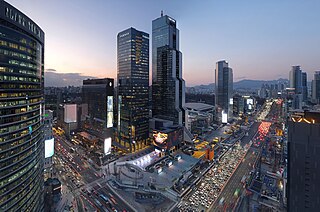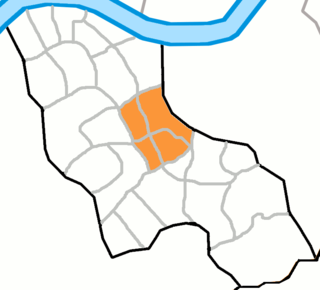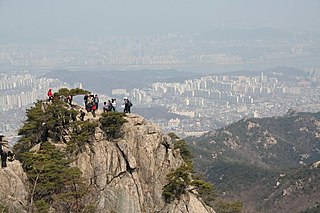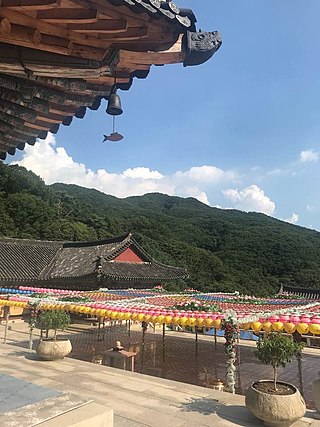
Yongin is a city in the Seoul Capital Area,the largest in Gyeonggi Province,South Korea. With a population over 1 million,the city has developed rapidly since the 21st century,recording the highest population growth of any city in the country. Yongin is home to Everland and Caribbean Bay,South Korea's most popular amusement and water parks. The city is also home to the Korean Folk Village,the largest of its kind. Yongin-si is a multi-nuclear city with multiple urban centers,not a single nuclear structure,and Giheung-gu crosses the Yeongdong Expressway and Dongbaek,while Suji-gu crosses Pungdeokcheon Stream and Jukjeon.

Yangjae Station is a station on the Seoul Subway Line 3 and Shinbundang Line. It was the southern terminus of Line 3 until October 30,1993,when the line was extended to Suseo station,and it became a transfer station with the Shinbundang Line on October 28,2011. It is located in Yangjae-dong,Seocho and Gangnam District,Seoul.

Maebong Station is a station on the Seoul Subway Line 3. It is located in Dogok-dong,Gangnam-gu,Seoul and was named after the nearby Maebongsan mountain.

Gangnam District is one of the 25 districts of Seoul,South Korea. The term Gangnam translates to "South of the [Han] River". Gangnam District is the third largest district in Seoul,with an area of 39.5 km2 (15.3 sq mi). As of the 2017 census,Gangnam District had a population of 561,052. There is a high concentration of wealth in the district,with prices for an apartment as of 2020 nearly double those in the rest of Seoul. Gangnam District is part of Gangnam School District Eight,along with the Seocho District. This district shares half of Gangnam-daero Gangnam Station area with Seocho District,which is one of the most crowded places in South Korea.

Daechi-dong (대치동) is an affluent neighborhood in Gangnam-gu,Seoul,South Korea. Daechi-dong is divided into three different “dongs”which are Daechi 1-dong,2-dong,and 4-dong. Daechi-dong is predominantly considered the residential area of Gangnam. As a result,real estate in the area is highly competitive and expensive compared to other parts of Gangnam. The Yangjaecheon is a stream that runs through the heart of Daechi-dong.

Gwanaksan (Korean: 관악산) is a mountain in southern Seoul,South Korea. Portions lie in the Gwanak District and Geumcheon District districts of Seoul;other portions lie in the neighboring cities of Anyang,Gyeonggi and Gwacheon.

Tancheon (Korean: 탄천) is a stream in Gyeonggi Province and Seoul,South Korea. The stream is a tributary of the Han River. It begins in Yongin,Gyeonggi Province,flows through Seongnam,and eventually into the Han. It has a total length of 35.6 kilometres.

Seocho District is one of the 25 local government districts which make up the city of Seoul,South Korea. Seocho is a part of the Gangnam region,along with the Gangnam district of Seoul. Seocho District ranks as one of the richest neighborhoods in South Korea and among the most expensive areas in Seoul with an average sales price of 47.75 million South Korean won per 3.3 square meters. Many of the wealthiest residents are concentrated in the three Gangnam districts including Seocho,known as Gangnam School District Eight.

Seocho-dong is a dong,or neighborhood of the greater Gangnam area Seocho-gu district of the South Korean city of Seoul. Seocho-dong is divided into 4 different dong which are Seocho 1-dong,2-dong,3-dong and 4-dong. The main street is Teheranno. There is Gangnam Station in Seocho-dong,which is one of the biggest stations in Korea.

Dogok-dong is an affluent ward of Gangnam-gu in Seoul,South Korea. It is home to high-end residential homes including the Samsung Tower Palace,a luxury residential complex which contains the eleventh-tallest building in South Korea.

Banpo-dong is a dong,neighborhood of Seocho-gu,the greater Gangnam area in Seoul,South Korea. Banpo-dong is divided into five different dong which are Banpobon-dong,Banpo 1-dong,2-dong,3-dong and 4-dong.

Yangjae-dong is a dong,neighbourhood of the greater Gangnam area Seocho District in Seoul,South Korea. Yangjae-dong is divided into 2 different dong which are Yangjae 1-dong and 2-dong.
Umyeon-dong is a dong,neighbourhood of Seocho-gu in Seoul,South Korea is part of Gangnam District and a well-known,private neighborhood for the wealthy in southern Seoul. It is a legal dong (법정동) administered under its administrative dong (행정동),Yangjae 1-dong. The first syllable of the name is derived from Umyeonsan,or Mt. Umyeon due to the geographical feature of the area has the mountain.

Cheonggyesan (Korean: 청계산) is a mountain in South Korea. It extends over the district of Seocho-gu in Seoul,the national capital,and the cities of Gwacheon,Uiwang,and Seongnam in the province of Gyeonggi-do. It has an elevation of 620 m (2,034 ft).

Yangjae Citizen's Forest (Maeheon) Station is a subway station in Seoul,South Korea,on Seoul Metropolitan Subway's Shinbundang Line. It opened on October 28,2011. The subway station appears in episode 1 of the Netflix TV show Squid Game where the main character Gi-hun,is recruited into the death games.
National Route 47 is a national highway in South Korea connects Ansan to Cheorwon County. It established on 14 March 1981.

Seoul Metropolitan City Route 41 is a trunk road located in Seoul,South Korea. With a total length of 9.18 km (5.70 mi),this road starts from Umyeon-dong in Seocho District,Seoul to Suseo station in Gangnam District.
Yangjae-daero (Korean: 양재대로) is a road located in Gyeonggi Province and Seoul,South Korea. With a total length of 19.36 km (12.03 mi),this road starts from the Seonam Interchange in Seocho District,Seoul to Acheon Interchange in Guri,Gyeonggi.
Seoul Yangjae High School is a public high school located in Gangnam School District Eight,Seocho-dong,Seocho-gu,Seoul,Korea. This school is directly managed by Gangnam Education Office of the Government of South Korea. The Korean meaning of the school name means qualified student (良才·Yangjae). YHS is K-wave star Lee Jong-suk's alma mater and this is school chosen by many aspiring Korean top-tier students or entertainers living in the Gangnam area. The number of students per grade at Yangjae High School is about 300,around 20 percent of YHS students enter to Seoul National University,Korea University,and Yonsei University (SKY) annually. YHS campus is connected to the National Diplomatic Academy of Korea (국립외교원) and Seocho District Government Office (서초구청). Yangjae Station of Gangnam Seocho District is located right next to YHS.

Gangnam,sometimes referred to as the Greater Gangnam Area,is a geographic and cultural region in Seoul. While Gangnam can refer to the entire region of Seoul south of the Han River,the region is generally defined as consisting of the city's affluent Gangnam,Seocho and Songpa districts. Other definitions define Gangnam by the boundaries of the Gangnam Eighth School District or by the commercial zones around Gangnam Highway,Yangjae Station,Sinsa Station,Nonhyeon Station,Sinnonhyeon Station and Gangnam station. These definitions exclude the Songpa District,which has been argued to be culturally and administratively distinct from the Gangnam and Seocho districts.
















